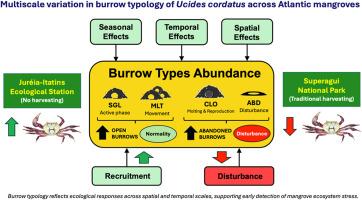Multiscale variation in the burrow typology and abundance of Ucides cordatus across Atlantic mangroves: effects of time, space, and climate
IF 2.6
3区 地球科学
Q1 MARINE & FRESHWATER BIOLOGY
引用次数: 0
Abstract
Understanding ecological processes across spatial and temporal scales is crucial for interpreting population dynamics and guiding conservation efforts. However, multiscale influences on decapod crustacean populations remain underexplored. We investigated the variability in Ucides cordatus burrow typologies across two protected Brazilian mangrove ecosystems: Juréia-Itatins Ecological Station (JIES) and Superagui National Park (SNP). Sampling involved 120 quadrats (5 × 5 m each), with five quadrats allocated to each mangrove zone (fringe and apicum) at both conservation units, during summer and winter seasons over three consecutive years (2016–2018). Generalised linear models tested the effects of year, season, site, and tidal zone on the abundance of five burrow types: SGL (single-opening), MLT (multi-opening), OPE (sum of SGL and MLT), CLO (closed), and ABD (abandoned). We observed marked interannual and seasonal variability, especially under climatic anomalies, along with spatial contrasts driven by tidal flooding patterns and microhabitat structure. Burrow types reflected distinct functional phases: SGL and MLT were linked to active behaviour and responded sharply to environmental variation; CLO was associated with reproduction or moulting; ABD indicated environmental stress or recolonisation. Fringe zones exhibited greater variability and reduced open burrow abundance under stressful conditions. Integrating burrow typologies with spatiotemporal factors proved an effective, non-invasive approach for detecting ecological shifts and assessing habitat quality. Our findings reinforce the role of U. cordatus as a bioindicator species and support the use of burrow-based metrics in the long-term monitoring and conservation of mangrove ecosystems facing increasing climatic and anthropogenic pressures.

大西洋红树林梭鲈洞穴类型和丰富度的多尺度变化:时间、空间和气候的影响
了解跨时空尺度的生态过程对于解释种群动态和指导保护工作至关重要。然而,对十足甲壳类动物种群的多尺度影响仍未得到充分探索。研究了巴西两个受保护的红树林生态系统:jur - itatins生态站(JIES)和superaguui国家公园(SNP)中Ucides cordatus穴居类型的变异。采样涉及120个样方(每个5 × 5 m),在连续三年(2016-2018)的夏季和冬季,在两个保护单元的每个红树林带(边缘和顶)分配5个样方。广义线性模型测试了年、季节、地点和潮汐带对5种洞穴类型丰度的影响:SGL(单开口)、MLT(多开口)、OPE (SGL和MLT之和)、CLO(封闭)和ABD(废弃)。我们观察到明显的年际和季节变化,特别是在气候异常下,以及潮汐洪水模式和微生境结构驱动的空间差异。洞穴类型反映了不同的功能阶段:SGL和MLT与活跃行为有关,对环境变化反应强烈;CLO与繁殖或换毛有关;ABD表明环境压力或再定殖。在压力条件下,边缘区表现出更大的变异性和减少的开放洞穴丰度。将洞穴类型与时空因子相结合是一种有效的、非侵入性的生态转移检测和栖息地质量评估方法。我们的研究结果加强了U. cordatus作为生物指示物种的作用,并支持在面临日益增加的气候和人为压力的红树林生态系统的长期监测和保护中使用基于洞穴的指标。
本文章由计算机程序翻译,如有差异,请以英文原文为准。
求助全文
约1分钟内获得全文
求助全文
来源期刊
CiteScore
5.60
自引率
7.10%
发文量
374
审稿时长
9 months
期刊介绍:
Estuarine, Coastal and Shelf Science is an international multidisciplinary journal devoted to the analysis of saline water phenomena ranging from the outer edge of the continental shelf to the upper limits of the tidal zone. The journal provides a unique forum, unifying the multidisciplinary approaches to the study of the oceanography of estuaries, coastal zones, and continental shelf seas. It features original research papers, review papers and short communications treating such disciplines as zoology, botany, geology, sedimentology, physical oceanography.

 求助内容:
求助内容: 应助结果提醒方式:
应助结果提醒方式:


